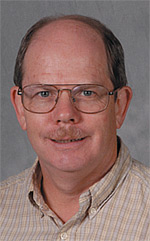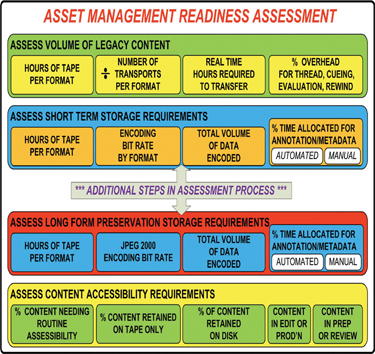Strategies for Asset Management

How much "asset management" is sufficient to meet the business requirements of your operation? In assessing an appropriate level of implementation, a "readiness" analysis is the first step in determining what level of systems is necessary.
Initially, the assessment program would include a review of the enterprise's legacy content based on current formats on which the content is stored, the health of the physical media, and the available capabilities for the migration of the legacy content to its new digital environment.
If the organization currently uses videotape from its libraries, their legacy tape transports may still be operational. Older legacy content should be addressed first due to the likelihood that the transports or media may expire sooner than expected.
MIGRATION VIA ROBOTICS
Before implementing the digitization program, the transport mechanical conditions should be thoroughly reviewed by an entity that can make the proper adjustments and replace components, which, if not properly aligned, risk destroying these tapes during playback. Of particular vulnerability is improperly stored videotape with many passes or thread cycles over its lifetime.
Specialty robot or manual migration products are tailored to not only handle this delicate, vulnerable media; but can also analyze the media's condition from a performance perspective before damage can occur. Optical sensors detect both surface and edge damage looking for potential hidden tape folding or stretching. Reduced surface reflectivity indicates potential magnetic media deterioration. These transports handle tape at one-tenth the tension of a VTR transport and report cleaning status out to an XML format database, thus reducing risk.
Content to be migrated may be for preservation purposes, repurposing or to free up valuable online disk storage space. Decisions on which course to take may add incremental monetary value to the enterprise in any case. When repurposing is the main thrust, users must assess if the archive management system can be configured with search and annotation capabilities.
If so, the migration platform may need auto-scene change detection, facial and scene background recognition, speech-to-text or closed-caption reading capabilities. Proxy generation, found in most systems, may be desired for asset registration, search, browse or preview purposes.
Long-term content preservation should utilize a high-quality encoding scheme such as JPEG2000 to capture the content at as high a resolution and least lossy form as possible. A determination to correct or process the content during digitization, or to capture it "raw," is a decision that becomes part of the media asset management readiness report.
Appropriate forms of disk space must be allocated, with the volume of migrated material being just one factor. Additional assessment considers the migration workflow period, degree of automated versus manual processes, and human labor factors necessary to annotate and validate the accuracy of the metadata captured. These factors become part of a "strategy for digitization," which helps define the degree of hardware and software requirements necessary.
Findings in this strategy might divulge it as more cost effective to outsource these activities versus owning or leasing the systems outright. From the finance side, the ROI is assessed in part upon long-term utilization.

Partial list of considerations for a media asset management readiness study and strategy for digitizationMETADATA REQUIREMENTS
Looking at near-term storage, spinning disks may be required when sophisticated annotation (metadata) is needed before migrating the data to a permanent tape-based library. Although proxies may satisfy this short-term annotation effort (yielding less disk space), the study should look at how workflow is impacted in any operational mode. When content is accessed on a routine basis, a greater near line (disk) storage requirement is needed versus when program length episodics are migrated to digital tape for preservation before the legacy media can no longer be reproduced.
The library that becomes the content's new home can take on other dimensions beyond the number of storage platform tape bins. The assessment process must consider content accessibility requirements once moved to LTO tape, DVD/Blu-ray or even the cloud.
The relationship between content ingested into the library versus content restored from the archive helps ascertain how many LTO tape drives, disk writers or how much network bandwidth is necessary to meet the overall system bandwidth and utilization targets.
IT infrastructures must be examined from a physical hardware and a user/interaction perspective. Since content will reside in a file-based environment, the systems, which ingest, retrieve and repurpose this content, should be matched to the enterprise's needs and capabilities. Local and geographically separated facilities will require additional conditions to be met.
From these findings, a statement of requirements for the asset management system is prepared with appropriate documentation and recommendations from which to move forward. Short-stepping this effort can turn the migration project into a disaster or reduce the ROI overall. This activity should, therefore, be undertaken by those with familiarity in all aspects of media production, workflow processes and enterprise business practices or management.
Karl Paulsen is a technologist and consultant to the digital media and entertainment industry. Karl recently joined Diversified Systems as a Senior Engineer. He is a SMPTE Fellow, member of IEEE, SBE Life Member and Certified Professional Broadcast Engineer. Contact him atkpaulsen@divsystems.com.
Get the TV Tech Newsletter
The professional video industry's #1 source for news, trends and product and tech information. Sign up below.

Karl Paulsen recently retired as a CTO and has regularly contributed to TV Tech on topics related to media, networking, workflow, cloud and systemization for the media and entertainment industry. He is a SMPTE Fellow with more than 50 years of engineering and managerial experience in commercial TV and radio broadcasting. For over 25 years he has written on featured topics in TV Tech magazine—penning the magazine’s “Storage and Media Technologies” and “Cloudspotter’s Journal” columns.
